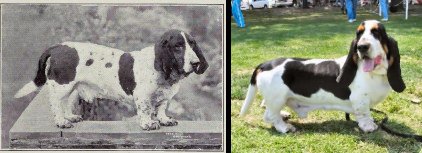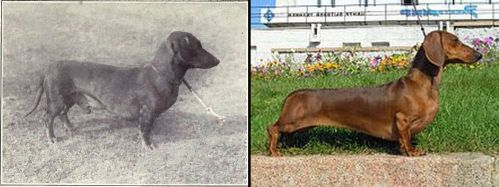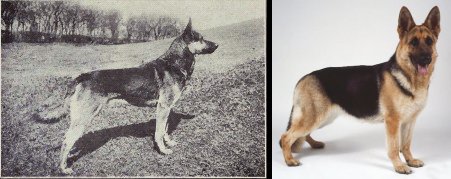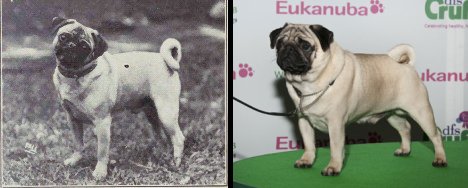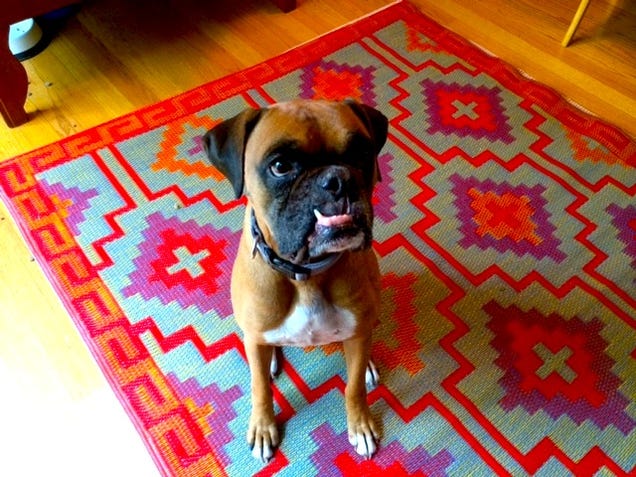Dog enthusiasts will frequently tell you that certain dogs have certain characteristics: Golden Retrievers are friendly, German Shepherds are protective, and Corgis are smarter than a fifth grader. But is a dog's breed really such a great predictor of its personality?
This is Skoda—or Dr. Emil Skoda if you want to be formal. He is, as far as I know, roughly seven years old and a purebred Boxer. He's going to help us out in this discussion.
What Defines a Breed, Anyway?
We can't really talk about whether breeds are predictive of personality without first understanding what a breed is. Breed, naturally, has to do with breeding. Skoda is (presumably) a Boxer because his dame and sire were (presumably) both Boxers. Simple, right?
Well, it's a little more complicated than that. Many of our current dog breeds are fairly recent innovations, a product of Victorian-era attempts to produce superior dogs. The early breeders responsible for our modern purebred dogs actually crossbred dogs with characteristics they found desirable, and eventually created a genetically limited pool of dogs that would reliably produce pups with similar traits. The Boxer, for example, goes back just 150 years, after breeders began crossing a progenitor of the English Bulldog with a now-extinct breed known as the Brabanter Bullenbeisser. Skoda is a Boxer because he is descended from dogs that someone has termed "Boxer," but he, like other Boxers, is fairly recently related to Bulldogs and any other dog bred from the Bullenbeisser. Today, dog breeds represent closed gene pools; in order to qualify as a Boxer, Skoda has to come from an unbroken lineage of Boxers—with no ancestors from any other breed—going back decades.
Most dog lovers recognize Skoda as a Boxer (although he's occasionally mistaken for a Bulldog or a Pit Bull) because of his smushed-in nose, his lean body, his short, floppy ears, his arched skull, and that adorable underbite. (The snaggletooth, while cute, is one of many reasons he doesn't quite physically conform to breed standards.) They don't check to see if he's suspicious of strangers (he is), patient with children (yes, but he hates babies), alert (to a fault), or energetic (he starts bouncing up and down at the mere mention of a W-A-L-K), but they do make assumptions about his personality.
This recognition of breeds through appearance more or less fits with the breed standards as defined by show organizations like Britain's Kennel Club and the American Kennel Club. If you watch conformation shows like Crufts or the Westminster Kennel Club Dog Show, the judges are looking for physical conformation to breed standards. If Skoda were to compete in a conformation show (something that wouldn't happen for a number of reasons), judges would be looking at his size, the shape of his body, the color of his coat, his gait, the proportions of his skull, and a host of other largely physical traits. (Although he would be penalized for "evidence of shyness, or lack of dignity or alertness," so my wary goofball might not do well on that front, either.)
Kennel club breed standards are controversial on a number of fronts, not the least of which is concern that certain physically desired traits aren't particularly healthy for dogs.The modern English Bulldog is a rather extreme example; their skin folds make them prone to dermatitis; their flat, wide, short-snouted heads make it difficult for them to breathe and regulate their bodily temperature (Boxers have that problem, too); and it is extraordinarily difficult for them to give birth: more than 80 percent of English Bulldog litters are delivered by Caesarian section. There are also additional health concerns related to the limited gene pool; for example, Boxers and Golden Retrievers are at extremely high risk of developing cancer.
It's worth noting that not all dog breeds are recognized by kennel clubs, but major kennel club recognition can have an effect on genetic diversity within a breed. In a
2003 paper published in the Journal of Heredity, researchers found a much lower correlation between heterozygosity (having different alleles at a particular genetic locus) of a breed with its population size than with the dates the breed was recognized by the AKC registry. Breeds that had been recognized by the AKC more recently had a significantly greater heterozygosity than breeds that had long been on the AKC registry.
Some breed enthusiasts oppose kennel club conformation standards for a reason that is much more pertinent to our discussion here: because it emphasizes morphological traits over behavioral ones. The United States Border Collie Club (USBCC) was founded in 1975 in part to oppose the AKC's use of appearance standards, rather than behavioral standards, for Border Collies. The Border Collie is, after all, a herding dog, and fans of the breed tend to prize it precisely for those qualities that make them good herders, such as stalking, chasing, and grab-biting. A Border Collie, by that rationale, should not be judged primarily for the shape of its body, and certainly not for its willingness to hold its head up in a conformation ring. If you're interested in more on the relationship between the AKC and Border Collies, Donald McCaig documents how the dispute played out in the 1990s in his book
The Dog Wars: How the Border Collie Battled the American Kennel Club.
Certain behaviors, such as those related to hunting and other working skills, do correlate strongly with breeds. But does that mean that breeds truly fit their personality stereotypes?
Breeds and their Behaviors
Dogs are particularly interesting subjects for genetic research. The canine genome has been sequenced, and dogs vary wildly in terms of not just morphology, but behavior. Dogs are the most physically varied animal to walk the Earth, and they also have divergent emotional experiences, ones that differ from those of their wolf brethren. A
2004 study published in Molecular Brain Research compared gene expression in the hypothalamus, which controls certain emotional and endocrine responses, in wild canids and dogs, and found that while gene expression was highly conserved in wild canids, it was much more divergent in wolves, suggesting that the behavioral selection that occurred during domestication resulted in rapid changes in brain gene selection.
It seems that every week we are learning something new about the genetics behind dogs' physical appearances, and there are various research projects underway to better understand the genetic links to canine behavior. In 1965, John Paul Scott and John L. Fuller analyzed the genetic component of our dogs' personalities by testing various behavioral traits across breeds for their seminal text
Genetics and the Social Behavior of the Dog, and our understanding of behavioral genetics is growing with time and technology. A
2006 study found a pattern of co-inheritance for sixteen different traits in two breeds of dog. In 2011,
Behavioral Genetics published the results of a 50-year study to map the loci of genes for domestication and aggression in foxes. The University of California, San Francisco, has collected DNA and surveys related to thousands of dogs for its Canine Behavioral Genetics Project, and it will be interesting to see what the project's research ultimately yields. But much of our understanding of breeds and behavior comes from decades of human observation.
The American Journal of Human Genetics paper
"Canine Behavioral Genetics: Point Out he Phenotypes and Herding up the Genes" provides an excellent round-up of canine behavior as understood in 2008. There are certain behaviors that correlate so closely with breeds, which members of these breeds perform without any sort of encouragement or training, that they must have a genetic component. These traits are most obvious in working breeds. As we mentioned earlier, you want a herding dog that will interact with livestock, stalking it, chasing it, and nipping at its legs. However, if you want a dog that guards livestock, such as a Great Pyrenees, you want a dog that will not stalk or interact with livestock. The Human Genetics paper notes that behaviors like pointing, retrieving, tracking, and drafting likely have strong genetic components. Humans have selected for these behaviors in their hunting and working dogs, and it appears to have worked.
Now, certain physical and behavioral traits may be linked. In the famous "Farm-Fox" experiment launched by geneticist Dmitri Belyaev, the researcher bred silver foxes who were friendly towards people, creating and increasingly reliable stock of tame foxes. As he bred his tame foxes, their appearances changed over the generations; their pricked ears folded over and they became more puppy-like in appearance. Border Collies suffer disproportionately from noise phobia, which may be a byproduct of a desired trait—the one that makes Border Collies able to obey a voice command or whistle given from hundreds of feet away.
However, we must be careful not to assume that, just because a trait may have a genetic component, it exists across members of a breed. After all, we've established that Border Collies raised for the show ring show different behaviors than Border Collies raised for work, and we'll need more research into whether show Border Collies are suppressing a natural urge, or if they differ genetically from their working cousins. And behavioral traits that we may think of as common in certain breeds aren't necessarily universal; Janis Bradley's essay in
The Bark about her lazy greyhound—and whether greyhounds are particularly predisposed toward racing behavior—is particularly enlightening.
How You Affect Your Dog's Personality
Anyone who has owned a dog knows that their personality doesn't spring completely from genetics. Just like humans, dogs are affected by their experiences and their environment—and their personalities can change over time. I strongly suspect that my usually sweet Skoda turns into a bundle of snapping rage at the veterinarian's office because of some painful mange treatments he endured while in foster care. And dogs that have suffered abuse at the hands of humans frequently have deep (but not necessarily indelible) emotional scars.
The idea that dogs' personalities are affected by their experiences is a key component of dog training. Common wisdom holds that the window for ensuring your dog socializes well with other dogs is very narrow; after the first 16 weeks of the puppy's life, the window is supposedly closed. Plus, the current emphasis on positive, reward-based training is based on numerous studies on the effects of positive and negative feedback dog behavior.
There is a particularly fascinating paper published in Behavioural Processes in 2009 that looks at how dogs' personality traits link to non-breed characteristics of dogs as well as the demographics of their owners. The study found that reported calmness correlated with the following factors: whether a dog was neutered or intact, the age of the dog, the age of the owner, the owner's level of education, the age at which the dog was acquired by the owner, how many hours the dog and the owner spent together, and how much training the dog received. This is, of course, just one study, but research is increasingly looking at dogs not just as collections of genes and responses to stimuli, but also as fellow inhabitants in our human environments. We're still learning how dogs develop within human-controlled environments, but it's clear that this is a large part of what makes your dog who he or she is.
What About Mutts?
More than half of all dogs in the United States are mixed breeds, and but even if your mutt has purebred grandparents, you can't necessarily predict its nature. Scott and Fuller studied breed differences in American Cocker Spaniels and Basenjis (as well as other breeds), such as reactivity to a doorbell, problem-solving, and spatial relations, and then crossbred the dogs. They found that the first generation offspring tended to have intermediate performance on behavioral tests relative to their parents, although behavioral patterns grew more complicated in subsequent generations. Nearly three decades later, geneticist Jasper Rine performed a crossbreeding experiment of his own, breeding his Border Collie Gregor (named, of course, for Gregor Mendel) with his Newfoundland Pepper. The first generation of puppies, as with Scott and Fuller's Cocker-Basenji mixes, exhibited a combination of their parents' traits: they loved water like Gregor and hunted down tennis balls with the eagerness of Pepper. But Pepper and Gregor's traits weren't so clearly combined in the next generation of pups, their grandpuppies. These puppies had some of Pepper and Gregor's traits, but the combinations of those traits varied from puppy to puppy. While the behavioral characteristics of Pepper and Gregor's children were predictable to Rine, the characteristics of their grandchildren were not. Just because one of a particular puppy's grandparents was a Newfoundland, that didn't mean the puppy had any interest in swimming.
There's another hazard to assuming a mutt's personality based on its presumed parentage: you might have the parentage wrong. When Scott and Fuller bred their Cocker-Basenji mixes, the second generation of pups showed a great variety in physical appearance and didn't look much at all like the original parents. (Edit: A study released by the
National Canine Research Council found that dogs of unknown origin are frequently mis-labeled when it comes to breed.) Appearance, it turns out, isn't a reliable indicator of breed, so if you're using a dog's physical form as clues to its personality, you'll have little luck if that dog is a mystery breed.
READ THIS STORY AND MORE AT......

